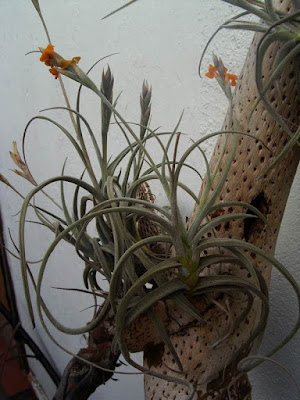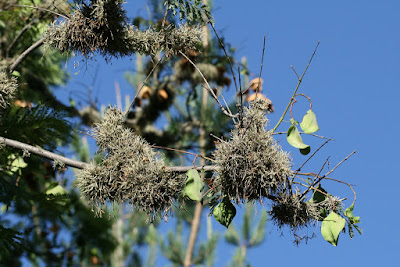Tillandsia caliginosa is native to Bolivia and the borders of northern Argentina. It has a very uniform habit, only in the area of Tarija (Dept Tarija, Bolivia) is there a strong tomentose form. It is found at various altitudes ranging from 0 to just over 1250 meters...
Tillandsia caliginosa also called as Tillandsia crocata f. major, Tillandsia crocata var. tristis, Tillandsia myosura, is a species of the genus Tillandsia. This species was described by Walter Till in 1984.
IDENTIFY TILLANDSIA CALIGINOSA AIR PLANTS
Tillandsia caliginosa is native to Bolivia and the borders of northern Argentina. It has a very uniform habit, only in the area of Tarija (Dept Tarija, Bolivia) is there a strong tomentose form. It is found at various altitudes ranging from 0 to just over 1250 meters.
It is a small sized, caulescent epiphyte, which reaching 20 to 40 cm high, with simple or branched, 8 cm long, 0.5 cm thick stem, that have 8-12 distichous, horizontal spreading to reflexed, 12 to 18 cm long, lineal subulate, long attenuate, rolled inwards, 2 to 5 mm thick, dense grey lepidote, scales eccentric leaves from 2 cm long, 2.4 cm wide, lively green, strongly nerved naked sheath.
This air plants species blooms on simple, laxly distichous, to 6 cm long and 0.5 to 1 cm wide, 2 to 4 flowered, strongly lepidote, flat, erect or flexuous rhachis visible inflorescence with fragrant, sessile, non-tubular, 2 cm long flowers. The color of the petals varies from yellow to dark brown with sometimes yellow shades in the center. Stamens and style deeply enclosed.
TILLANDSIA CALIGINOSA AIR PLANTS CARE AND CULTURE
Cultural information should only be used as a guide, and should be to be adapted to suit you. Your physical location; where you grow your plants, how much time you have to devote to their care, and many other factors, will need to be taken into account. Only then can you decide on the cultural methods that best suit you and your plants.
Light:
Tillandsia caliginosa loves a lot of light, but it does not react positively if it is exposed to direct sunlight, especially during the summer and especially if it is not accustomed: for this reason it is better to protect it by shielding it from the rays with a curtain or in any other way (as long as it remains a luminous position anyway).
Temperature:
This air plants likes temperatures between 10-12 ° C and 30-32 ° C, if the temperature rises above these values, the plant must be moved to a cooler place, otherwise its leaves will evaporate too much water and the plant will suffer. When temperatures allow it, it could be outdoors in a place protected from rain, direct sunlight and do not let the plant face night temperatures below 5 ° C, especially if it is wet.
Mounting:
This air plant can grow as epiphyte on a piece of wood for example or grow as lithophyte on a mineral support. You can place the plant very close to a window when grow it indoors in the winter and preferably outdoors in the summer with partial shade.
Watering:
Tillandsia caliginosa should be sprayed every day (if kept indoors) or 2 times a day (if kept outdoors) during the hot months and every 1-2 days during the cold months. Obviously when it rains and you grow it outside, it counts as a watering. Good aeration is required, the plant must dry quickly (in less than an hour).
Fertilizer:
Fertilizing is not absolutely necessary to survival, but will increase the growth and vigor of the plants and their blooms. This species need a fertilizer that can be absorbed directly in to the plant via the leaves and use Bromeliad fertilizer (17-8-22) twice a month in summer, once a month in winter is recommended. You can also use the fertilizer for orchids with 1/4 of the dose indicated on the bottle.

















COMMENTS